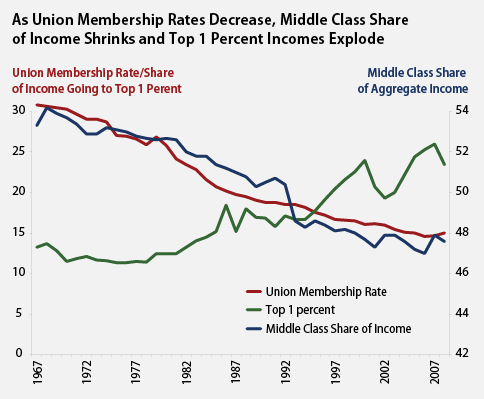Zaid Jilani writes: This evening, House Majority Leader Eric Cantor (R-VA) will give a speech at the University of Pennsylvania’s Wharton School of Business about how to address income inequality, likely trying to capitalize on the 99 Percent Movement he once derided as unruly “mobs.” Although exactly what policies Cantor will suggest to deal with this social problem are unknown, it’s unlikely that he will touch on one of the chief drivers of American income inequality: the decline of unions.
As CAP’s David Madland and Nick Bunker show in the following chart, the middle class’s share of national income has steadily declined as the percentage of the population in labor unions has fallen. At the same time, the top 1 percent’s share of national income has exploded:
War in Context
… with attention to the unseen



This graph is a pile of poop. For example, if you look at 2007, the ‘middle class share of income’ is 42%, and the ‘top 1%’ is 48%- that would mean that there are only 2 classes, one ‘rich’ and the other ‘middle class’- what about all the poor people in the world- don’t they count for anything too? All of the years add up like this- there is no other classes, other than ‘top 1%’ and ‘the 99%’- is this some sort of redefining of ‘middle class’ to mean ‘everyone else’?
This graph simply shows that the ‘top 1%’ had their share of that national income grow over a 50 year time period from 48% to 52%- is this what the whole OWS movement is about? If so, that’s a pretty marginal thing to get so upset about.